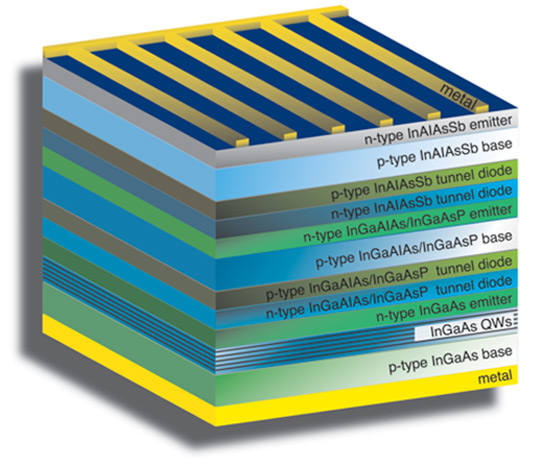- News
15 January 2013
NRL designs multi-junction solar cell to raise efficiency record from 44% to beyond 50%
In collaboration with Imperial College London in the UK and MicroLink Devices Inc of Niles, IL, USA, researchers in the US Naval Research Laboratory’s Electronics Technology and Science Division have proposed a novel triple-junction solar cell which they reckon has the potential to exceed 50% energy conversion efficiency (the current goal in multi-junction photovoltaic development).
“This research has produced a novel, realistically achievable, lattice-matched, multi-junction solar cell design with the potential to break the 50% power conversion efficiency mark under concentrated illumination,” says NRL research physicist Robert Walters PhD. “At present, the world-record triple-junction solar cell efficiency is 44% under concentration, and it is generally accepted that a major technology breakthrough will be required for the efficiency of these cells to increase much further,” he adds.
In multi-junction (MJ) solar cells, each junction is tuned to different wavelength bands in the solar spectrum to increase efficiency. High-bandgap semiconductor material is used to absorb the short-wavelength radiation, with longer-wavelength parts transmitted to subsequent semiconductor layers with different energy bandgaps. In theory, an infinite-junction cell could obtain a maximum power conversion percentage of nearly 87%, says NRL. The challenge is to develop a semiconductor material system that can attain a wide range of bandgaps and be grown with high crystalline quality.

Picture: Schematic diagram of a multi-junction (MJ) solar cell formed from materials lattice-matched to InP and achieving the bandgaps for maximum efficiency. (Photo: U.S. Naval Research Laboratory)
By exploring novel semiconductor materials and applying band-structure engineering, via strain-balanced quantum wells, the NRL research team has produced a design for a MJ solar cell that can achieve direct band gaps from 0.7eV to 1.8eV with materials that are all lattice-matched to an indium phosphide (InP) substrate.
“Having all lattice-matched materials with this wide range of bandgaps is the key to breaking the current world record,” adds Walters. “It is well known that materials lattice-matched to indium phosphide (InP) can achieve bandgaps of about 1.4eV and below, but no ternary alloy semiconductors exist with a higher direct bandgap.”
NRL says that the primary innovation enabling this new path to high efficiency is the identification of InAlAsSb quaternary alloys as a high-bandgap material layer that can be grown lattice-matched to InP. Drawing from their experience with antimony (Sb)-based compounds for detector and laser applications, NRL researchers have modeled the band-structure of InAlAsSb and showed that this material could potentially achieve a direct bandgap as high as 1.8eV. With this result, and using a model that includes both radiative and non-radiative recombination, the NRL scientists have created a solar cell design that is a potential route to power conversion efficiency of more than 50% under concentrated solar illumination, it is reckoned.
After being awarded funding for a US Department of Energy (DoE) Advanced Research Projects Agency-Energy (ARPA-E) project at the end of November, the NRL scientists - working with MicroLink and Rochester Institute of Technology of Rochester, NY – aim to execute a three-year materials and device development program to realize the new solar cell technology.
NRL Multi-junction solar cells





